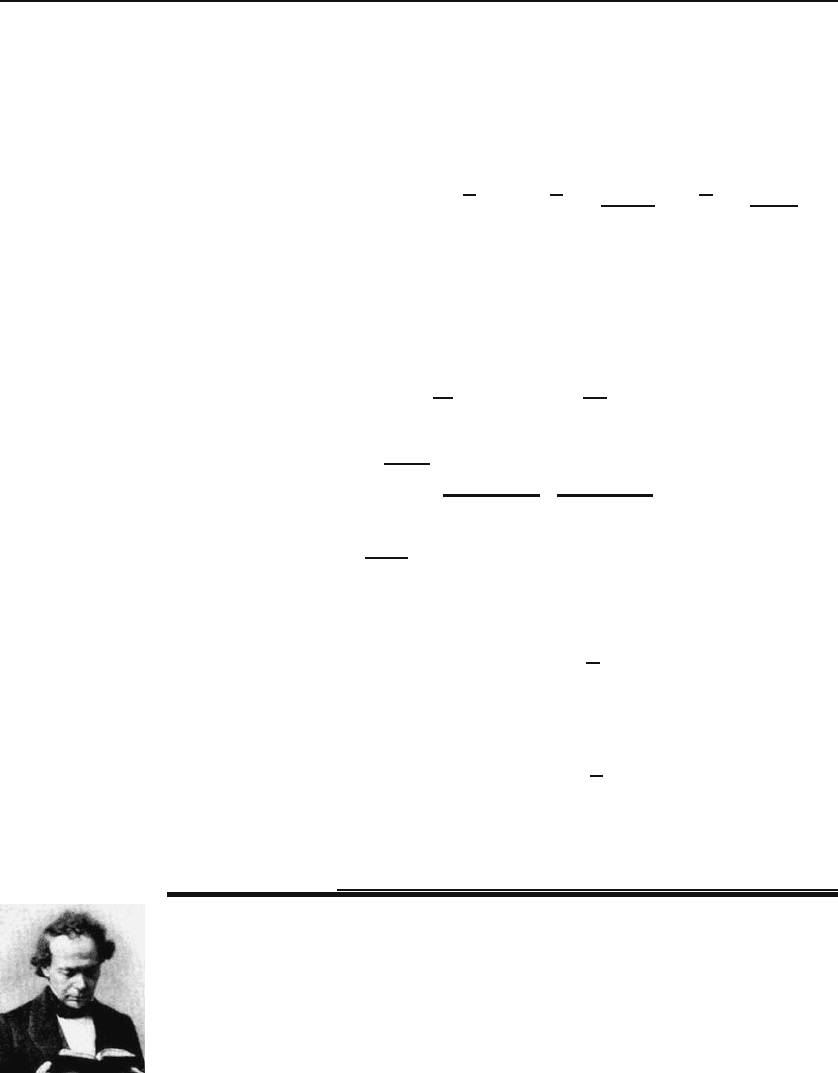Hassani S. Mathematical Methods: For Students of Physics and Related Fields
Подождите немного. Документ загружается.


28.2 The Schr¨odinger Equation 669
Construction of Hermite Polynomials
The fact that we are interested in the behavior of ψ (and therefore, H)asx
(or y) goes to infinity permits us to concentrate on the very large powers of y
in the series for H(y). Hence, separating the even and odd parts of the series,
we may write
H(y)=
∞
k=0
c
2k
y
2k
+
∞
k=0
c
2k+1
y
2k+1
= P
2M+1
(y)+
∞
k=M+1
c
2k
y
2k
+
∞
k=M+1
c
2k+1
y
2k+1
(28.11)
= P
2M+1
(y)+
∞
k=0
c
2k+2M+2
y
2k+2M+2
+
∞
k=0
c
2k+2M+3
y
2k+2M+3
,
where P
2M+1
(y) is a generic polynomial obtained by adding all the “small”
powers of the series, and M is a very large number.
6
Now note that for very
large n, the recursion relation yields
c
n+2
≈
2n
(n +1)(n +2)
c
n
≈
2n
(n)(n)
c
n
≈
2
n
c
n
⇒ c
n
≈
2
n − 2
c
n−2
.
A few iterations give
c
n
≈
2
k
(n −2)(n − 4) ···(n −2k)
c
n−2k
.
In particular,
c
2k+N
≈
2
k
(2k + N −2)(2k + N −4) ···(N)
c
N
. (28.12)
To find the coefficients in Equation (28.11), first let N =2M + 2 and obtain
c
2k+2M+2
≈
2
k
(2k +2M )(2k +2M −2) ···(2M +2)
c
2M+2
=
2
k
[2(k + M)][2(k + M −1)] ···[2(M +1)]
c
2M+2
(28.13)
=
1
(k + M)(k + M −1) ···(M +1)
c
2M+2
=
M!
(k + M)!
c
2M+2
.
Similarly
c
2k+2M+3
≈
2
k
(2M +1)!!
(2k +2M +1)!!
c
2M+3
=
2
k
[2(M +1)]!/[2
M+1
(M +1)!]
[2(k + M +1)]!/[2
k+M+1
(k + M +1)!]
c
2M+3
=2
2k
[2(M + 1)]!(k + M +1)!
(M + 1)![2(k + M +1)]!
c
2M+3
, (28.14)
6
In particular, M is very large compared to λ of Equation (28.10).

670 Other PDEs of Mathematical Physics
where we used the result of Problem 11.1. By using the Stirling approximation
(11.6), the reader may verify that
c
2k+2M+3
≈
(M +1)!
(k + M +1)!
c
2M+3
. (28.15)
With the coefficients given in terms of two constants (c
2M+2
and c
2M+3
),
Equation (28.11) becomes
H(y)=P
2M+1
(y)+c
2M+2
M!y
2
∞
k=0
y
2k+2M
(k + M)!
+ c
2M+3
(M +1)!y
∞
k=0
y
2k+2M+2
(k + M +1)!
= P
2M+1
(y)+c
2M+2
M!y
2
∞
j=M
y
2j
j!
+ c
2M+3
(M +1)!y
∞
j=M+1
y
2j
j!
. (28.16)
The first sum over j can be reexpressed as follows:
∞
j=M
y
2j
j!
=
∞
j=0
(y
2
)
j
j!
−
M−1
j=0
y
2j
j!
= e
y
2
− Q
2M−2
(y),
where Q
2M−2
(y) is a polynomial of degree 2M − 2iny. The second sum in
(28.16) can be expressed similarly. Adding all the polynomials together, we
finally get
H(y) ≈ P
2M+1
(y)+c
2M+2
M!
≡β
M
y
2
e
y
2
+ c
2M+3
(M +1)!
≡α
M
ye
y
2
= P
2M+1
(y)+(α
M
y + β
M
y
2
)e
y
2
. (28.17)
Let us now go back to ψ(y) and note that
ψ(y)=H(y)e
−y
2
/2
≈ P
2M+1
(y)e
−y
2
/2
→0asy →∞
+(α
M
y + β
M
y
2
)e
y
2
/2
→∞ as y →∞
because any exponential decay outweighs any polynomial growth. It follows
that, if H(y) is an infinite series, ψ(y) will diverge at infinity.Fromaphysical
standpoint this means that the quantum particle inside the harmonic oscillator
potential well has an infinite probability of being found at infinity!
7
To avoid this unrealistic conclusion, we have to reexamine H(y). The caseTruncation of the
infinite series gives
the quantization
of harmonic
oscillator energy
levels.
of Legendre polynomials tells us that the infinite series needs to be truncated.
This will take place only if the numerator of the recursion relation vanishes for
some n, i.e., if λ =2m for some integer m. An immediate consequence of such
a truncation is the famous quantization of the harmonic oscillator energy:
2m = λ =
2E
ω
− 1 ⇒ E =(m +
1
2
)ω.
The polynomials obtained by truncating the infinite series are called the
Hermite polynomials. We now construct them. With λ =2m, the recursion
Hermite
polynomials
relation (28.10) can be written as
7
The Copenhagen interpretation, the only valid interpretation of quantum mechan-
ics, states that |ψ(x)|
2
is the probability density for finding the particle at x.

28.2 The Schr¨odinger Equation 671
c
n
=
2(n − m − 2)
n(n − 1)
c
n−2
= −
2(m +2− n)
n(n −1)
c
n−2
,m≥ n ≥ 2.
The upper limit for n is due to the truncation mentioned above. After a few
iteration, the pattern will emerge and the reader may verify that
c
n
=(−1)
k
2
k
(m +2−n)(m +4− n) ···(m +2k −n)
n(n − 1) ···(n − 2k +1)
c
n−2k
. (28.18)
We need to consider the two cases of even and odd n separately. For n =2k,
we get
c
2k
=(−1)
k
2
k
m(m −2) ···(m +2− 2k)
(2k)!
c
0
. (28.19)
Now, since the numerator of (28.10) must vanish beyond some integer, and
since 2n =4k,wemusthaveλ =4j or m = λ/2=2j for some integer j.
Then, the reader may check that
c
2k
=(−1)
k
2
2k
j!
(2k)!(j − k)!
c
0
(28.20)
and
H
2j
(y)=c
(j)
0
j
k=0
(−1)
k
2
2k
j!
(2k)!(j − k)!
y
2k
, (28.21)
where we have given the constant a superscript to distinguish among the c
0
’s
of different j’s. The odd polynomials can be obtained similarly:
H
2j+1
(y)=c
(j)
1
j
k=0
(−1)
k
2
2k+1
j!
(2k +1)!(j − k)!
y
2k+1
. (28.22)
The constants are determined by convention. To adhere to this convention,
we define
c
(j)
0
=
(−1)
j
(2j)!
j!
,c
(j)
1
=
(−1)
j
(2j +1)!
j!
.
The reader may check that, with these constants, the Hermite polynomials of
all degrees (even or odd) can be concisely written as
H
n
(y)=
[n/2]
r=0
(−1)
r
n!
(n − 2r)!r!
(2y)
n−2r
, (28.23)
where [a], for any real a, stands for the largest integer less than or equal to a.
Orthogonality of Hermite Polynomials
The Hermite polynomials satisfy an orthogonality relation resembling that of
the Legendre polynomials. We can obtain this relation by multiplying the DE

672 Other PDEs of Mathematical Physics
for H
m
(x)byH
n
(x)e
−x
2
,andtheDEforH
n
(x)byH
m
(x)e
−x
2
and subtract-
ing. The factor e
−x
2
, the so-called weight function, may appear artificial inweight function
for Hermite
polynomials
this derivation, but an in-depth analysis of the classical orthogonal polyno-
mials, of which Hermite and Legendre polynomials are examples, reveals that
such weight functions are necessary. The reason we did not see such a factor
in Legendre polynomials was that for them, the weight function is unity.
8
At
any rate, the result of the above suggested calculation will be
(H
m
H
n
− 2xH
m
H
n
− H
n
H
m
+2xH
n
H
m
)e
−x
2
+(2m −2n)H
m
H
n
e
−x
2
=0.
The reader may easily verify that the first term is the derivative of
(H
m
H
n
− H
n
H
m
)e
−x
2
,
so that
d
dx
*
(H
m
H
n
− H
n
H
m
)e
−x
2
+
+(2m − 2n)H
m
H
n
e
−x
2
=0
and if we integrate this over the entire real line, we obtain
(H
m
H
n
− H
n
H
m
)e
−x
2
∞
−∞
+(2m −2n)
#
∞
−∞
H
m
(x)H
n
(x)e
−x
2
dx =0.
The first term vanishes because of the exponential factor. It now follows that
if m = n,then
orthogonality of
Hermite
polynomials
#
∞
−∞
H
m
(x)H
n
(x)e
−x
2
dx =0. (28.24)
Generating Function for Hermite Polynomials
We constructed the generating function for Legendre polynomials in Chapter
26. Here we want to do the same thing for Hermite polynomials. By definition,
the generating function must have an expansion of the form
g(t, x)=
∞
n=0
a
n
t
n
H
n
(x),
where a
n
is a constant to be determined. Differentiate both sides with respect
to x assuming that t is a constant:
dg
dx
=
∞
n=1
a
n
t
n
H
n
(x).
The sum starts at 1 because H
0
(x) = 0. Use the result of Problem 28.7 to
obtain
dg
dx
=
∞
n=1
a
n
t
n
(2n)H
n−1
(x)=2t
∞
n=1
na
n
t
n−1
H
n−1
(x).
8
We have no space to go into the details of the theory of classical orthogonal polynomials,
but the interested reader can find a unified discussion of them in Hassani, S. Mathematical
Physics: A Modern Introduction to Its Foundations, Springer-Verlag, 1999, Chapter 7.

28.2 The Schr¨odinger Equation 673
Now choose the constant a
n
in such a way that it satisfies the recursion relation
na
n
= a
n−1
. It then follows that
dg
dx
=2t
∞
n=1
a
n−1
t
n−1
H
n−1
(x)=2t
∞
m=0
a
m
t
m
H
m
(x)=2tg.
Thus
dg
g
=2tdx ⇒ ln g =2tx +lnC(t) ⇒ g(t, x)=C(t)e
2tx
,
where the “constant” of integration has been given the possibility of depending
on the other variable, t. To find this constant of integration, we first determine
a
n
:
a
n
=
a
n−1
n
=
a
n−2
n(n −1)
= ···=
a
n−k
n(n − 1) ···(n − k +1)
···=
a
0
n!
.
Using our results obtained so far, we get
C(t)e
2tx
= a
0
∞
n=0
t
n
n!
H
n
(x) →
∞
n=0
t
n
n!
H
n
(x),
where in the last step we absorbed a
0
(really 1/a
0
) in the “constant” C(t).
To determine C(t), evaluate both sides of the equation at x =0andusethe
result of Problem 28.8. This yields
C(t)=
∞
n=0
t
n
n!
H
n
(0) =
∞
k=0
t
2k
(2k)!
(−1)
k
(2k)!
k!
=
∞
k=0
(−t
2
)
k
k!
= e
−t
2
.
It follows that
e
2tx−t
2
=
∞
n=0
t
n
n!
H
n
(x). (28.25)
We now summarize what we have done:
generating
function for
Hermite
polynomials
Box 28.2.1. The nth coefficient of the Maclaurin series expansion of the
generating function g(t, x) ≡ e
2tx−t
2
about t =0is H
n
(x).Specifically,
H
n
(x)=
∂
n
∂t
n
e
2tx−t
2
t=0
. (28.26)
We can put the result above to immediate good use. Let us square both
sides of Equation (28.25), multiply by e
−x
2
, and integrate the result from −∞

674 Other PDEs of Mathematical Physics
to +∞.FortheLHS,wehave
LHS =
#
+∞
−∞
e
2(2tx−t
2
)
e
−x
2
dx = e
−2t
2
#
+∞
−∞
e
−x
2
+4tx
dx
= e
−2t
2
#
+∞
−∞
e
−(x−2t)
2
+4t
2
dx = e
2t
2
#
+∞
−∞
e
−(x−2t)
2
dx
= e
2t
2
#
+∞
−∞
e
−u
2
du =
√
πe
2t
2
=
√
π
∞
n=0
(2t
2
)
n
n!
=
√
π
∞
n=0
2
n
t
2n
n!
,
where we introduced u = x − 2t for the integration variable, and used the
result of Example 3.3.1.
To square the RHS, we need to write it as the product of two infinite sums
using two different dummy indices! Therefore,
RHS =
#
+∞
−∞
∞
n=0
t
n
n!
H
n
(x)
∞
m=0
t
m
m!
H
m
(x)
e
−x
2
dx
=
∞
m,n=0
t
m+n
m!n!
#
+∞
−∞
H
m
(x)H
n
(x)e
−x
2
dx
=0 unless m = n by (28.24)
=
∞
n=0
t
2n
(n!)
2
#
+∞
−∞
[H
n
(x)]
2
e
−x
2
dx.
Comparing the LHS and the RHS, we conclude that
#
+∞
−∞
[H
n
(x)]
2
e
−x
2
dx =
√
π 2
n
n!.
We can combine this result and Equation (28.24) and write
#
+∞
−∞
H
m
(x)H
n
(x)e
−x
2
dx =
√
π 2
n
n!δ
mn
, (28.27)
where δ
mn
is the Kronecker delta which is 1 if m = n and 0 if m = n.
Historical Notes
Charles Hermite, one of the most eminent French mathematicians of the nine-
teenth century, was particularly distinguished for the clean elegance and high artistic
quality of his work. As a student, he courted disaster by neglecting his routine as-
signed work to study the classic masters of mathematics; and though he nearly
failed his examinations, he became a first-rate creative mathematician while still in
his early twenties. In 1870 he was appointed to a professorship at the Sorbonne,
where he trained a whole generation of well-known French mathematicians, includ-
ing Picard, Borel,andPoincar´e.
Charles Hermite
1822–1901
The character of his mind is suggested by a remark of Poincar´e: “Talk with
M. Hermite. He never evokes a concrete image, yet you soon perceive that the

28.2 The Schr¨odinger Equation 675
most abstract entities are to him like living creatures.” He disliked geometry, but
was strongly attracted to number theory and analysis, and his favorite subject was
elliptic functions, where these two fields touch in many remarkable ways. Earlier in
the century the Norwegian genius Abel had proved that the general equation of the
fifth degree cannot be solved by functions involving only rational operations and
root extractions. One of Hermite’s most surprising achievements (in 1858) was to
show that this equation can be solved by elliptic functions.
His 1873 proof of the transcendence of e was another high point of his career.
9
If he had been willing to dig even deeper into this vein, he could probably have
disposed of π as well, but apparently he had had enough of a good thing. As he
wrote to a friend, “I shall risk nothing on an attempt to prove the transcendence
of the number π. If others undertake this enterprise, no one will be happier than I
at their success, but believe me, my dear friend, it will not fail to cost them some
efforts.” As it turned out, Lindemann’s proof nine years later rested on extending
Hermite’s method.
Several of his purely mathematical discoveries had unexpected applications many
years later to mathematical physics. For example, the Hermitian forms and matrices
that he invented in connection with certain problems of number theory turned out
to be crucial for Heisenberg’s 1925 formulation of quantum mechanics, and Hermite
polynomials are useful in solving Schr¨odinger’s wave equation.
28.2.2 Quantum Particle in a Box
The behavior of an atomic particle of mass μ confined in a rectangular box
with sides a, b,andc (an infinite three-dimensional potential well) is gov-
quantum particle
in a box
erned by the Schr¨odinger equation for a free particle, i.e., V =0. Withthis
assumption, the first equation of (28.5) becomes
∇
2
ψ +
2μE
2
ψ =0.
A separation of variables, ψ(x, y, z)=X(x)Y (y)Z(z), yields the ODEs:
d
2
X
dx
2
+ λX =0,
d
2
Y
dy
2
+ σY =0,
d
2
Z
dz
2
+ νX =0,
with λ + σ + ν =2μE/
2
(see Example 22.2.1).
These equations, together with the boundary conditions
ψ(0,y,z)=ψ(a, y, z)=0 ⇒ X(0) = 0 = X(a),
ψ(x, 0,z)=ψ(x, b, z)=0 ⇒ Y (0) = 0 = Y (b), (28.28)
ψ(x, y, 0) = ψ(x, y, c)=0 ⇒ Z(0) = 0 = Z(c),
9
Transcendental numbers are those that are not roots of polynomials with integer
coefficients.

676 Other PDEs of Mathematical Physics
lead to the following solutions:
X
n
(x)=sin
nπ
a
x
,λ
n
=
nπ
a
2
for n =1, 2,...,
Y
m
(y)=sin
mπ
b
y
,σ
m
=
mπ
b
2
for m =1, 2,...,
Z
l
(z)=sin
lπ
c
z
,ν
l
=
lπ
c
2
for l =1, 2,...,
where the multiplicative constants have been suppressed.
The BCs in Equation (28.28) arise from the demand that the probability
quantum
tunneling
of finding the particle be continuous and that it be zero outside the box. This
is not true for a particle inside a finite potential well, in which case the particle
has a nonzero probability of “tunneling” out of the well.
The time equation has a solution of the form
T (t)=e
−iω
lmn
t
where ω
lmn
=
2μ
A
nπ
a
2
+
mπ
b
2
+
lπ
c
2
B
.
The solution of the Schr¨odinger equation that is consistent with the bound-
ary conditions is, therefore,
ψ(x, y, z, t)=
∞
l,m,n=1
A
lmn
e
−iω
lmn
t
sin
nπ
a
x
sin
mπ
b
y
sin
lπ
c
z
.
The constants A
lmn
are determined by the initial shape ψ(x, y, z, 0) of the
wave function. In fact, setting t = 0, multiplying by the product of the three
sine functions in the three variables, and integrating over appropriate intervals
for each coordinate, we obtain
A
lmn
=
8
abc
#
a
0
dx
#
b
0
dy
#
c
0
dzψ(x, y, z, 0) sin
nπ
a
x
sin
mπ
b
y
sin
lπ
c
z
.
The energy of the particle is
E = ω
lmn
=
2
π
2
2μ
n
2
a
2
+
m
2
b
2
+
l
2
c
2
.
Each set of three positive integers (n, m, l)representsaquantum state of
the particle. For a cube, a = b = c ≡ L, and the energy of the particle is
E =
2
π
2
2μL
2
(n
2
+ m
2
+ l
2
)=
2
π
2
2μV
2/3
(n
2
+ m
2
+ l
2
), (28.29)
where V = L
3
is the volume of the box. The ground state is (1, 1, 1), has
energy E =3
2
π
2
/2μV
2/3
, and is nondegenerate (only one state corresponds
to this energy). However, the higher-level states are degenerate. For instance,

28.2 The Schr¨odinger Equation 677
the three distinct states (1, 1, 2), (1, 2, 1), and (2, 1, 1) all correspond to the
same energy, E =6
2
π
2
/2μV
2/3
. The degeneracy increases rapidly with
larger values of n, m,andl.
Equation (28.29) can be written as
n
2
+ m
2
+ l
2
= R
2
where R
2
=
2μEV
2/3
2
π
2
.
This looks like the equation of a sphere in the nml-space. If R is large, the
number of states contained within the sphere of radius R (the number of states
with energy less than or equal to E) is simply the volume of the first octant
10
of the sphere. If N is the number of such states, we have
N =
1
8
4π
3
R
3
=
π
6
2μEV
2/3
2
π
2
3/2
=
π
6
2μE
2
π
2
3/2
V.
Thus the density of states (the number of states per unit volume) is then
density of states
n =
N
V
=
π
6
2μ
2
π
2
3/2
E
3/2
. (28.30)
This is an important formula in solid-state physics, because the energy E is
(with minor modifications required by spin) the Fermi energy.IftheFermi
Fermi energy
energy is denoted by E
f
, Equation (28.30) gives E
f
= αn
2/3
where α is some
constant.
28.2.3 Hydrogen Atom
When an electron moves around a nucleus containing Z protons, the potential
energy of the system is V (r)=−Ze
2
/r. In units in which and the mass of
the electron are set equal to unity, the time-independent Schr¨odinger equation
of (28.5) gives
∇
2
Ψ+
2E +
2Ze
2
r
Ψ=0.
The radial part of this equation is given by the first equation in (22.16) with
f(r)=2E +2Ze
2
/r. Defining u = rR(r), we may write
d
2
u
dr
2
+
λ +
a
r
−
α
r
2
u =0, (28.31)
where λ =2E and a =2Ze
2
. This equation can be further simplified by
defining r ≡ kz (k is an arbitrary constant to be determined later):
d
2
u
dz
2
+
λk
2
+
ak
z
−
α
z
2
u =0.
10
This is because n, m,andl are all positive.

678 Other PDEs of Mathematical Physics
Choosing λk
2
= −
1
4
and introducing β ≡ a/(2
√
−λ) yields
d
2
u
dz
2
+
−
1
4
+
β
z
−
α
z
2
u =0. (28.32)
Let us examine the two limiting cases of z →∞and z → 0. For the first
case, Equation (28.32) reduces to
d
2
u
dz
2
−
1
4
u =0 ⇒ u = e
−z/2
.
For the second case the dominant term will be α/z
2
and the DE becomes
d
2
u
dz
2
−
α
z
2
u =0
for which we try a solution of the form z
m
with m to be determined by
substitution:
d
2
u
dz
2
= m(m −1)z
m−2
⇒ m(m − 1)z
m−2
−
α
z
2
z
m
=0 ⇒ α = m(m −1).
Recalling from Theorem 26.2.1 that α = l(l + 1), we determine m to be l +1.
Factoring out these two limits, we seek a solution for (28.32) of the form
u(z)=z
l+1
e
−z/2
f(z).
Substitution of this function in (28.32) gives a new DE:
f
+
2(l +1)
z
− 1
f
−
l +1− β
z
f =0. (28.33)
Multiplying by z gives
zf
+[2(l +1)− z]f
− (l +1− β)f =0
which is a confluent hypergeometric DE [see Equation (11.27)]. Therefore, as
the reader may verify, f is proportional to Φ(l +1− β, 2l +2;z). Thus, the
solution of (28.31) can be written as
u(z)=Cz
l+1
e
−z/2
Φ(l +1−β, 2l +2;z).
Laguerre Polynomials
An argument similar to that used in the discussion of a quantum harmonic
oscillator will reveal that the product e
−z/2
Φ(l+1−β,2l+2;z) will be infinite
unless the power series representing Φ terminates (becomes a polynomial).
This takes place only if (see Box 11.2.2)
l +1− β = −N (28.34)
